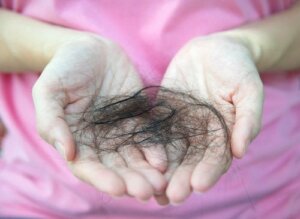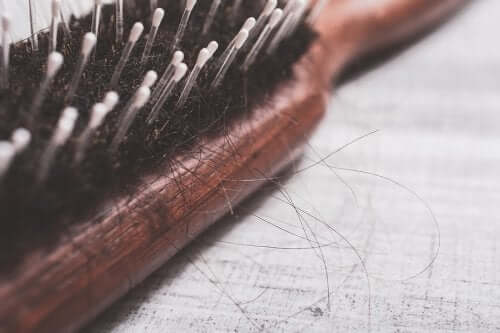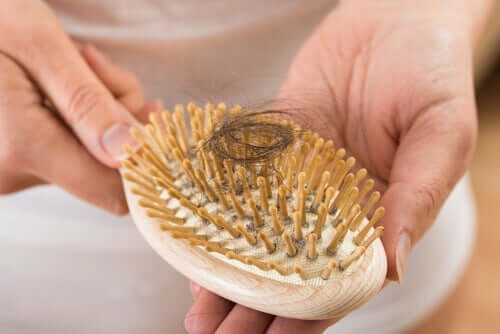What Do You Know About Postpartum Alopecia?

Postpartum alopecia is a temporary hair loss that appears in most women who have given birth. It appears two or three months after the baby is born. However, it’s not related to the type of breastfeeding the mother provides.
Causes of postpartum alopecia

The cause that produces this type of alopecia has to do with the changes and temporary hormonal processes that occur in the postpartum stage. However, other factors also play a role:
- Stress: During this period, the mother may feel under pressure or stressed by the new situation in her life.
- Iron levels: A decrease in iron levels occurs in a high percentage of women after childbirth and also affects hair loss.
The life cycle of hair
To understand the process of postpartum alopecia, it’s good to understand the biological cycle of hair. Each hair follicle has the capacity to develop 20 to 25 cycles. These cycles, as evidenced by this information from El farmacéutico: profesión y cultura, consist of 3 phases:
- Anagen phase: Refers to the growth phase and lasts between 2 and 6 years.
- Catagen phase: In this phase, hair growth stops. It lasts between 2 and 3 weeks.
- Telogen phase: This is the phase in which the hair falls out. This process takes place for 3 months, approximately. Then, the anagen phase starts again in the same follicle.
Normally, 90% of hair is in the growth phase, while the other 10% is in the falling out phase. However, during pregnancy, the levels of estrogen and thyroid hormones keep the hair in the anagen phase. This is why many pregnant women notice that their hair is healthier and fuller during pregnancy.
You may also be interested in: Seasonal Hair Loss: Why Does It Happen in the Fall?
Postpartum alopecia

After birth, hormone levels are restored in such a way that all the hair that was growing suddenly goes into the falling out phase. Therefore, two or three months after giving birth, mothers will suffer from postpartum alopecia.
If a woman loses between 50 and 100 hairs a day in the pre-pregnancy stage, during the postpartum stage it can triple to as much as 500 hairs a day.
The duration of postpartum alopecia is usually 4 to 6 months. However, restoring volume will take several more months and will also vary from case to case.
Anemia and postpartum alopecia
Iron deficiency anemia, or iron deficiency, is very common in women in the postpartum stage. This is due to the considerable blood loss during labor and postpartum, as this study published in the Revista Peruana de Ginecología y Obstetricia points out.
The lack of iron leads to a decrease in hemoglobin, so the amount of oxygen needed can’t be transported to the tissues. For this reason, hair bulbs, in the long run, are not well nourished and weaken, which favors the appearance of postpartum alopecia.
Similarly, factors such as the following can also contribute to the weakening of the hair bulb and, therefore, to postpartum alopecia:
- Fatigue
- Lack of sleep
- Changes in eating habits
- Stress due to new obligations and tending to the baby
Read also: Pharmaceutical Treatments of Anemia
Prevention and treatment of postpartum alopecia

To prevent and alleviate the symptoms of postpartum alopecia, it’s necessary for women to carry out adequate hygiene and take care of their hair.
Use of products
Mothers should comb their hair delicately and use shampoos and products designed for postpartum alopecia. In addition, it’s best to limit the use of hairdryers, irons, rough brushes, and other treatments that can be aggressive to the hair.
Nutrition
As far as nutrition is concerned, the intake of all essential vitamins, trace elements, and amino acids must be ensured. In this sense, special attention must be paid to those linked to hair health, such as sulfurous amino acids, L-cysteine, and L-methionine. And this is pointed out by this research published in the Revista Chilena Dermatológica.
These amino acids participate in transporting iron and zinc to the scalp. Thus, zinc is vital for the formation of keratin, which is the most important protein of the hair.
At the same time, B group vitamins, including biotin, which regulates sebaceous secretion, and selenium, an antioxidant, play important roles in maintaining good hair health.
Millet extract, rich in vitamins, essential fatty acids, and minerals, as shown in this study published in Comprehensive reviews in food science and food safety, could help stop hair loss while stimulating hair growth.
In short, we hope this information will be helpful to you when it comes time to give birth. However, if you have any doubts about it, it’s always best to consult a health professional for guidance.
All cited sources were thoroughly reviewed by our team to ensure their quality, reliability, currency, and validity. The bibliography of this article was considered reliable and of academic or scientific accuracy.
- Braun, J., & Ripoll, M. (2019). Alopecia posparto. El farmacéutico: profesión y cultura, (573), 23-24. http://www.elfarmaceutico.es/index.php/profesion/item/9982-alopecia-posparto#.X1ULjC2b68p
- Breymann, C. (2012). Tratamiento de la anemia por deficiencia de hierro en el embarazo y en el posparto. Revista Peruana de Ginecología y Obstetricia, 58(4), 313-328. http://www.scielo.org.pe/scielo.php?script=sci_arttext&pid=S2304-51322012000400010
- Mardones, F. (2014). Productos capilares alternativos para alopecia: Mecanismos de acción y evidencia científica. Revista chilena dermatológica, 30, 51-58. http://www.sochiderm.org/web/revista/30_1/7.pdf
- MedlinePlus. (n.d.). Vitaminas B. MedlinePlus. https://medlineplus.gov/spanish/bvitamins.html
- Saleh, A. S., Zhang, Q., Chen, J., & Shen, Q. (2013). Millet grains: nutritional quality, processing, and potential health benefits. Comprehensive reviews in food science and food safety, 12(3), 281-295. https://onlinelibrary.wiley.com/doi/full/10.1111/1541-4337.12012
This text is provided for informational purposes only and does not replace consultation with a professional. If in doubt, consult your specialist.








